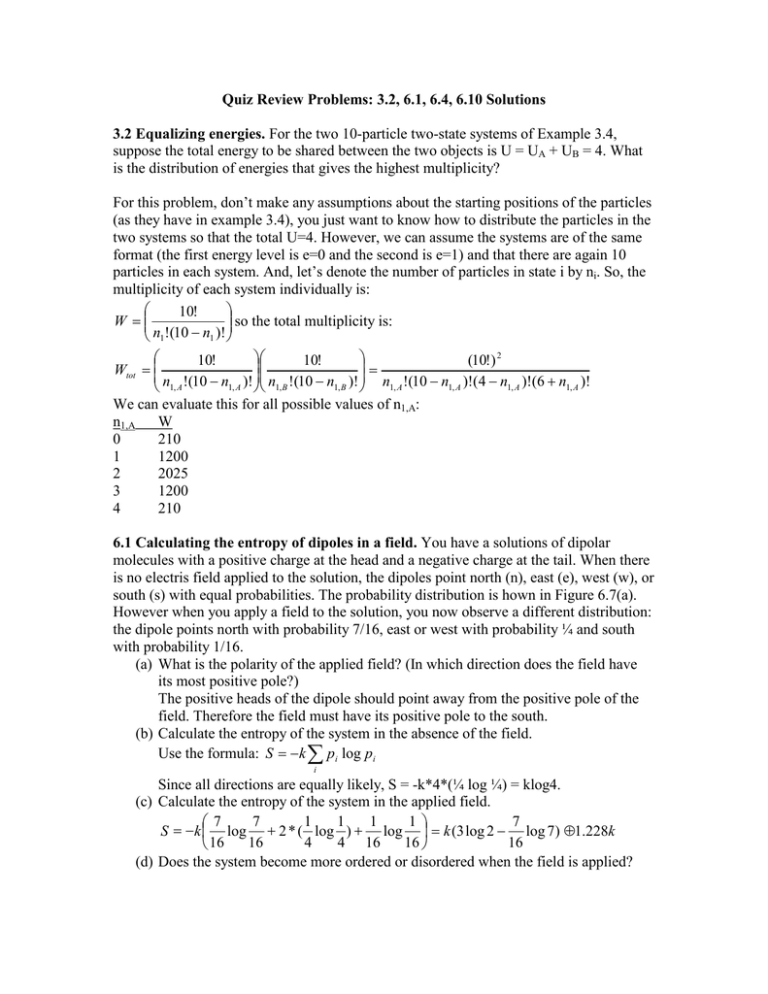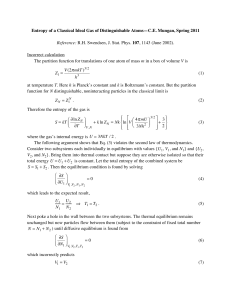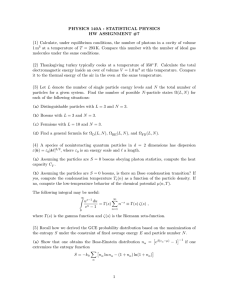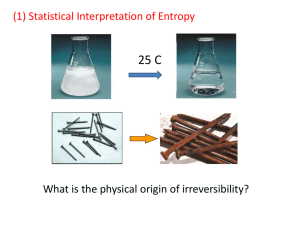Quiz Review Problems: 3.2, 6.1, 6.4, 6.10 Solutions 3.2 Equalizing energies.
advertisement

Quiz Review Problems: 3.2, 6.1, 6.4, 6.10 Solutions 3.2 Equalizing energies. For the two 10-particle two-state systems of Example 3.4, suppose the total energy to be shared between the two objects is U = UA + UB = 4. What is the distribution of energies that gives the highest multiplicity? For this problem, don’t make any assumptions about the starting positions of the particles (as they have in example 3.4), you just want to know how to distribute the particles in the two systems so that the total U=4. However, we can assume the systems are of the same format (the first energy level is e=0 and the second is e=1) and that there are again 10 particles in each system. And, let’s denote the number of particles in state i by ni. So, the multiplicity of each system individually is: 10 ! so the total multiplicity is: W = n n !(10 − )! 1 1 10! 10 ! (10!) 2 = Wtot = n1, A !(10 − n1, A )! n1, B !(10 − n1, B )! n1, A !(10 − n1, A )!(4 − n1, A )!(6 + n1, A )! We can evaluate this for all possible values of n1,A: n1,A W 0 210 1 1200 2 2025 3 1200 4 210 6.1 Calculating the entropy of dipoles in a field. You have a solutions of dipolar molecules with a positive charge at the head and a negative charge at the tail. When there is no electris field applied to the solution, the dipoles point north (n), east (e), west (w), or south (s) with equal probabilities. The probability distribution is hown in Figure 6.7(a). However when you apply a field to the solution, you now observe a different distribution: the dipole points north with probability 7/16, east or west with probability ¼ and south with probability 1/16. (a) What is the polarity of the applied field? (In which direction does the field have its most positive pole?) The positive heads of the dipole should point away from the positive pole of the field. Therefore the field must have its positive pole to the south. (b) Calculate the entropy of the system in the absence of the field. Use the formula: S = − k ∑ pi log p i i Since all directions are equally likely, S = -k*4*(¼ log ¼) = klog4. (c) Calculate the entropy of the system in the applied field. 7 1 1 1 1 7 7 S = − k log + 2 * ( log ) + log = k(3 log 2 − log 7) ≈ 1 .228k 16 4 4 16 16 16 16 (d) Does the system become more ordered or disordered when the field is applied? The entropy decreases when the field is turned on so the system becomes more ordered. 6.4 Calculating the entropy of mixing. Consider a lattice with N sites and n green particles. Consider another lattice, adjacent to the first, with M sites and m red particles. Assume that the green and red particles cannot switch lattices. This is state A. (a) What is the total number of configurations WA of the system in state A? N! M ! W A = W N * WM = n!( N − n)! m!( M − m)! (b) Now assume that all N+M sites are available to all the green and red particles. The particles remain distinguishable by their color. This is state B. Now what is the total number of configurations WB of the system? ( N + M )! WB = n!m!( N + M − n − m)! Now take N=M and n=m for the following two problems: (c) Using Stirling’s approximation on page 56, what is the ratio WA/WB? 2N 2 N − 2n N 2 N − 2n 2 W A N ! (n!) 2 (2 N − 2n)! e e 2 2 N −2 n ≈ ≈ ≈ 2 −2 n = 2N 2 N −2n N (2 N )! WB n!( N − n)! 2 2N N − n e e (d) Which state, A or B has the greatest entropy? Calculate the entropy difference given by: ∆S = SA – SB = kln(WA/WB). W ∆S = S A − S B = k log A ≈ k log 2 −2 n ≈ −2nk log 2 < 0 WB so SA < SB. 6.10 Maximum entropy for a three-sided die. You have a three-sided die, with numbers 1,2 and 3 on the sides. (So the values we can observe are ε1=1, ε2=2, ε3=3. For a series of N dice rolls, you observe an average score <ε> per roll using the maximum entropy principle. (a) Write expressions that show how to compute the relative probabilities of occurrence of the three sides, n1*/N, n2*/N and n3*/N, if α is given. Like the example in the book, we can use the Boltzmann probabilities to maximize the e − βε i entropy. So the general form for each probability is: pi = 3 ∑ e − βε i i =1 To simplify, take x = e−β so p1 = x , p2 = 2 x x3 , . p = 3 x + x2 + x3 x + x2 + x3 x + x2 + x3 3 x + 2 x 2 + 3x 3 We know that: ε = ∑ ε i p i so α = x + x2 + x3 i =1 We can solve this for x in terms of α by using the quadratic equation: x= α − 2 + (2 − α ) 2 − 4(3 − α )(1 − α ) α − 2 + − 3α 2 + 12α − 8 = 2(3 − α ) 2(3 − α ) To get the probability of turning up a 1, 2, or 3, we would first calculate x and then plug back in to the equations for p1, p2, and p3. (b) Compute n1*/N, n2*/N and n3*/N if α=2. x=1 so p1=p2=p3 = 1/3. (c) Compute n1*/N, n2*/N and n3*/N if α=1.5. 13 − 1 x= ≈ 0.4343 so p1= 0.6162 p2= 0.2627 and p3 = 0.1162 2 (d) Compute n1*/N, n2*/N and n3*/N if α=2.5. 13 − 1 x= ≈ 2.3028 so p1= 0.1162 p2= 0.2627 and p3 = 0.6162. 6







